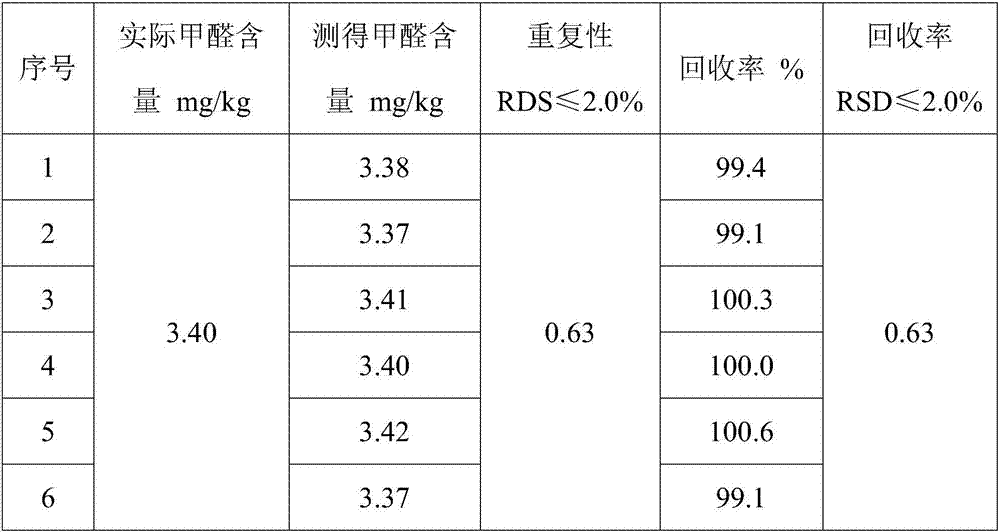Method for preprocessing meat food sample while detecting formaldehyde
A technology for sample pretreatment and meat food, which is applied in the preparation of test samples and the measurement of color/spectral properties, etc., can solve the problems of low accuracy, prolonged shelf life, large colorimetric error, etc., and saves pretreatment time. , reduce operation steps, increase the effect of accuracy
- Summary
- Abstract
- Description
- Claims
- Application Information
AI Technical Summary
Problems solved by technology
Method used
Image
Examples
Embodiment 1
[0022] A method for pretreatment of meat food samples when detecting formaldehyde, including the following steps: pulverize the meat food, add it to water, adjust the temperature to 0°C, adjust the power to 300w, ultrasonic for 40min, then heat up to 90°C, keep it warm for 5min, Then cool down to 20℃, stand for 8h, centrifuge to take the supernatant; add hydroxylamine hydrochloride to the supernatant to dissolve, stir for 30min and mix well to obtain a sample solution, where the weight-volume (g / ml) ratio of meat food and water It is 10:1, and the molar volume (mmol / L) ratio of hydroxylamine hydrochloride to supernatant is 20:1.
Embodiment 2
[0024] A method for pretreatment of meat food samples when detecting formaldehyde, including the following steps: pulverize the meat food, add it to water, adjust the temperature to 4°C, adjust the power to 200w, ultrasonic 60min, then heat to 80°C, keep the temperature for 10min, Then lower the temperature to 10℃, let stand for 10 hours, centrifuge to take the supernatant; add hydroxylamine hydrochloride to the supernatant to dissolve, stir for 20 minutes and mix well to obtain the sample solution, where the weight-volume ratio of meat and water (g / ml) It is 5:1, and the molar volume (mmol / L) ratio of hydroxylamine hydrochloride to supernatant is 10:1.
Embodiment 3
[0026] A method for pretreatment of meat food samples when detecting formaldehyde, including the following steps: pulverize the meat food, add it to water, adjust the temperature to 1°C, adjust the power to 280w, ultrasonic for 45min, then heat up to 88°C, heat preservation for 6min, Then cool to 17℃, let stand for 8.5h, centrifuge to take the supernatant; add hydroxylamine hydrochloride to the supernatant to dissolve, stir for 28min and mix well to obtain a sample solution, where the weight and volume of meat and water (g / ml) The ratio is 10:1.3, and the molar volume (mmol / L) ratio of hydroxylamine hydrochloride to the supernatant is 18:1.
PUM
| Property | Measurement | Unit |
|---|---|---|
| wavelength | aaaaa | aaaaa |
| recovery rate | aaaaa | aaaaa |
Abstract
Description
Claims
Application Information
 Login to View More
Login to View More - R&D
- Intellectual Property
- Life Sciences
- Materials
- Tech Scout
- Unparalleled Data Quality
- Higher Quality Content
- 60% Fewer Hallucinations
Browse by: Latest US Patents, China's latest patents, Technical Efficacy Thesaurus, Application Domain, Technology Topic, Popular Technical Reports.
© 2025 PatSnap. All rights reserved.Legal|Privacy policy|Modern Slavery Act Transparency Statement|Sitemap|About US| Contact US: help@patsnap.com


